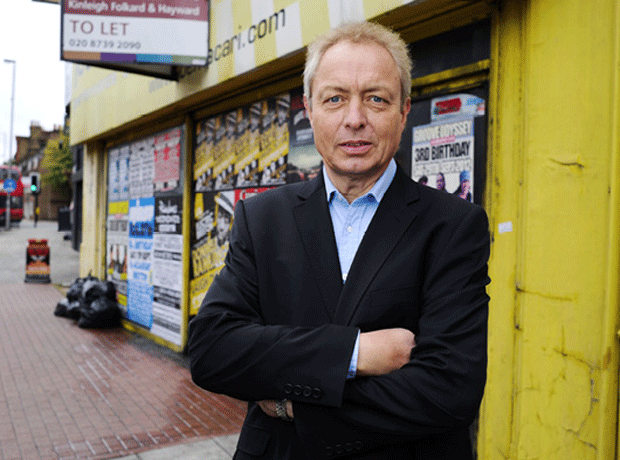
It’s nearly two years since Mary Portas paraded around Westminster with David Cameron in tow, having unveiled her rescue package for Britain’s embattled retailers.
This week, as Portas blasted Cameron and his ministers for failing to back her plans, it was the turn of one of her fiercest critics, former Iceland and Wickes boss Bill Grimsey, to hold court at the Houses of Parliament. The launch of his alternative vision, in a 57-page report, calls for a radical rethink of strategy, with an even more radical call for how to fund it.
Grimsey claims the supermarket giants, retail chains and leisure groups, having benefited from the boom years, should plough back £500m in the form of a one-off levy. Together with a proposed £300m raid on charity shops - courtesy of slashing their discretionary rate relief, the £800m war chest is a far cry from the petty sums the Portas review generated.
But while many of his 31 proposals - notably a call for an urgent review of the business rates system - have been met with widespread backing from retailers, Grimsey’s “community infrastructure levy”, a proposed one-off payment of 0.25% of one year’s sales in 2014, is highly contentious. The sums would fund town commissions, made up of retailers, property owners, local councils and residents, each overseen by a board of trustees. Each area would draw up a 20-year plan to create hubs with community facilities, leisure and night-time economies.
Grimsey Report:
How the proposed levy would impact on the big retailers
- Tesco:£105m
- Sainsbury’s:£58m
- Asda:£55m
- Morrisons:£45m
- Kingfisher :£26m
- M&S:£25m
- John Lewis:£21m
“The reality is that the supermarkets have increased their floorspace by more than 25% in the last five years,” says Paul Turner-Mitchell, a retail expert and entrepreneur who helped draw up the review. “There’s a strong argument that those supermarkets that have had such a tremendous effect on towns should bear the brunt. The idea of the levy is that big retailers give back a little bit.”
The definition of “little bit” is another matter, with the plans including all those with a UK turnover greater than £10m: 522 retailers (combined turnover £196bn) and 120 leisure businesses (£15bn). That would mean Tesco paying more than a fifth of the entire figure - £105m - with Sainsbury’s next hardest hit.
Business rates review backed
Yet sources point out Tesco already contributes £1.5bn in tax, including £0.5bn in business rates. “We don’t think it’s right to seek to penalise one part of the sector to fund delivery,” says Tom Ironside, BRC director of business and regulation. “We have a business rate system that is not fit for purpose and we completely agree with Grimsey’s call for a wholesale review. But I don’t see any appetite from the government to start taxing big retailers.”
“We are talking about swingeing taxes on retailers who would basically be writing an open cheque to fund a model that Grimsey admits is broken,” adds Neil Saunders, MD of Conlumino.
But that has not stopped the levy idea already raising its head at council level. In Bristol, the green party proposed that the largest stores should face an annual retail levy of 8.5% of profits. The plans, which would have raised an estimated £3.3m, with stores paying an average of £100,000 per year on top of business rates, were thrown out last month after a report to the council’s overview and scrutiny board claimed they would effectively have meant Bristol could be “considered closed for businesses”.
The report found the proposals could sabotage local Business Improvement Districts by hitting companies with a double whammy on funding. Nearly half of the businesses that would have been hit were in the town centre. “Retailers would have left Bristol in their droves,” says Christian Martin, deputy leader of the Lib Dem group on Bristol City Council. “The policy also misses the point,” he adds. “If we want to level the playing field for businesses, we need to be chasing the Amazons and the Jersey brigade, which are avoiding paying the same levels of tax as their rivals on the high street.”
“The danger of Grimsey’s levy is it’s a guaranteed way to kill off the exact type of investment from retailers we need,” adds one senior source involved in the government’s high street rescue.
However, devolved governments have other ideas. Since April 2012 Northern Ireland has operated a retail levy on properties with a rateable value of £500,000+, with retailers charged an additional 15% on top of rates, despite 40% of those operating in town centres.
In Scotland all large retail properties with a rateable value of £300,000+ which sell both alcohol and tobacco pay a public health supplement of their rates. Grimsey’s idea of a levy to improve the financial health of towns has split those running Business Improvement Districts south of the border. One leading source described the potential impact on BIDs as “disastrous” but Dr Julie Grail, chief executive of British BIDs, said the report was “more robust and realistic” than anything provided by Portas. “Clearly we are not keen on an indiscriminate levy on any scale of retailer but the principle of a well-informed levy to fund improvements to town centres is exactly what BIDs do,” she says. “If businesses are given a say in the proposition and the delivery, and ideally the investment is channelled through a BID vehicle, it may prove a positive approach.”
Grimsey himself says the time has come for retailers to bite the bullet, to help fund new start-ups and community enterprises as a further 20,000 stores will soon be obsolete, he argues. And Cameron thought Mary Portas was straight talking.



















No comments yet